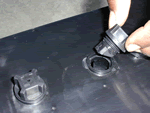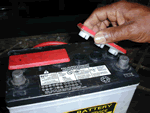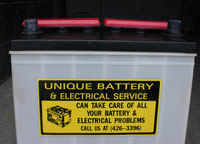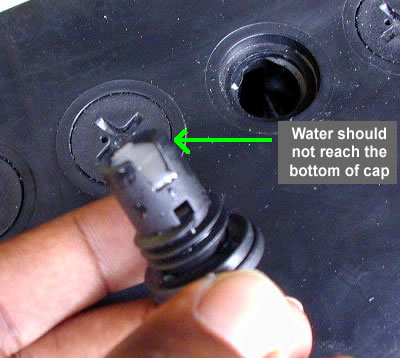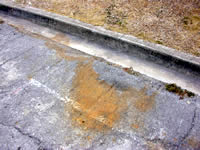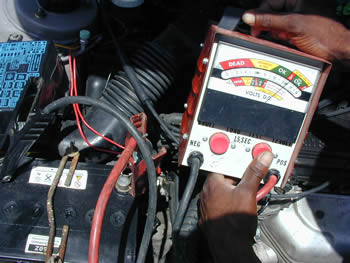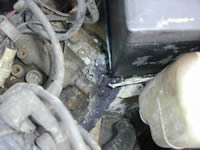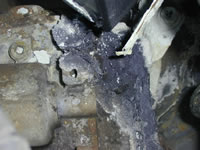 |
| Information provided by Unique Battery
& Electrical Service |
| |
| Do you know how to check your car's battery? Many drivers
often rely on gas station service attendants to check their car's battery
for water. Checking the battery for water quite a simple task that you can
learn to do on your own. But is there any other maintenance your battery
might need? Our research team interviewed the battery specialist at Unique
Battery & Electrical Service to find out. |
| |
| 1. How often should you check
the water? |
| 2. How do you remove the
battery cap to add the water? |
| 3. Does it matter if you use
Tap water or Distilled water? |
| 4. How much water should you
put in? |
| 5. What happens if you over
fill it? |
| 6. What happens if it runs
too low? |
| 7. How often should you check
the voltage? |
| 8. What should the voltage
read? |
| 9. What may be the cause of
a low voltage reading? |
| 10. How do you know when
the battery needs changing? |
| 11. Generally how often does
it need changing? |
| 12. How can I extend the
life of the battery? |
| 13. What causes the battery
to lose power? |
| 14. Is there anything you
should never do with a battery? |
| |
| |
| 1. How often should you check the water? |
| Once or twice every 3 months with a new battery. Once a
week, if the battery is older than 1½ years. |
| |
| 2. How do you remove the battery cap to
add the water? |
| Batteries have different types of caps. Some have caps you
can unscrew with your fingers, some you need to use a coin to unscrew them
and others you can pull off with your hand. See illustrations below. |
| |
|
|
| |
| 3. Does it matter if you use Tap water
or Distilled water? |
| Yes. You should use distilled water since it lacks the high
mineral content present in tap water. Barbados' tap water contains high
amounts of lime. The lime settles in the battery compartment causing the
development of a lime cell within the battery and inhibits the proper operation
of the lead acid cell. |
| |
| 4. How much water should you put in? |
| Some batteries have a low level and full level marking on
the battery. However, some batteries do not have a marking indicating the
level you should fill the water to. In such a case you should fill the battery
where the water level is below the bottom of the battery cap, when the cap
is replaced. |
| |
|
Battery Water Level Indicators
|
|
Battery with Text & line markings indicating
the Upper
& Lower Level
|
Battery with 2 Horizontal Bands
indicating the Upper
& Lower Level
|
|
|
|
|
For Batteries without indicators,
water level should be below the bottom of the Battery cap
|
|
|
|
| |
| |
| 5. What happens if you over fill the battery? |
| If you put too much water is in the battery, when the car
is started, the acid will spill. The reaction inside the battery when the
car is started causes the water level to rise. If there is too much water
in the battery, the rising water level from the reaction will cause the
water to overflow. This causes valuable acid inside the battery to be lost.
The acid is the conduit in which the electricity flows. The acid will cause
corrosion if it comes in contact with metal. |
| |
|
Corrosion caused by battery acid spills
|
|
|
|
|
| |
| Be careful where you wash off the sediments cause by the
corrosion since it will leave a stain. Big brown stains may not look to
good in your garage. |
| |
|
Stain left in road
|
|
|
| |
| 6. What happens if the water runs too
low? |
| Two serious problems occur by running the water level too
low. There is an increase in heat and a deterioration of battery plates.
This restricts the battery from charging and destroys the battery plates.
Just like overcharging this destruction can take place in a matter of 5
months. |
| |
| 7. When should you check the voltage? |
| You should check the voltage if the battery light indicator
in your dashboard remains on after starting the car. The light may also
flash while driving. |
| |
| 8. What should the voltage read? |
| For modern gas cars it is suggested that the voltage be 20%
more than the battery's voltage when the car is running. For example, with
a 12 volt battery, the voltage reading when the car is on should be 14.4
volts. (20% of 12 volts is 2.4 which gives 14.4 when added to 12) |
| |
| 9. What may be the cause of a low voltage
reading? |
- a low charging rate from the alternator,
- a malfunctioning charging system or
- a defective battery.
|
| 10. How do you know when the battery
needs changing? |
| You need to take it to a battery specialist and have it tested.
The specialist will check if the battery is serviced properly. (i.e. checks
the water level, voltage and its ability to deliver current) |
| |
|
Technician checking battery
|
|
|
| |
| 11. Generally how often does it need
changing? |
| Some batteries have a 3½ year life span. Ask your dealer
for the life span of their battery. |
| |
| 12. How can I extend the life of the
battery? |
- Make sure the battery is properly serviced.
- Make regular water checks
- Make sure battery terminal and leads are clean to ensure a good connection.
Leads can be cleaned with a steel brush or a terminal post cleaner.
- Make sure the battery is properly installed i.e. battery straps should
keep the battery from rocking. The bumps an unstable battery will receive,
especially from driving through potholes, will knock about 6-8 months
off the life of the battery.
- Install the appropriate battery to meet the power requirements of
your vehicle. It is better to have reserved capacity than too little.
|
| 13. What causes the battery to lose power? |
| By taking out more than you are putting in. When the car
is running, the car's alternator recharges the battery. If you do anything
to use the battery's power faster than it is being replaced, you will drain
the battery. High powered amplifiers for car stereos are often the culprits
of battery drain. When the car is off, the battery is not being recharged.
Therefore, running any appliance when the car is off will drain the battery.
Leaving on the lights or playing the stereo when the car is off are common
causes of battery drain. |
| |
| 14. Is there anything you should never
do with a battery? |
- You should never expose it to flame. The gasses emitted by batteries
can be explosive.
- Never short circuit the battery. It may explode.
- Prevent water inside battery from coming in contact with skin or
eyes, as it is acidic.
- Never lean over the battery while it is charging or being jump-started.
- Do not lift the battery by it sides. Applying pressure to the sides
may cause the battery acid to spill, especially batteries with plastic
cases. Use a battery carrier or lift it with your hands at opposite
corners.
|
| |
| |
| Information provided courtesy of Unique
Battery & Electrical Service |
| |
|
|

